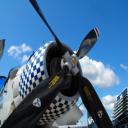Yahoo Answers is shutting down on May 4th, 2021 (Eastern Time) and beginning April 20th, 2021 (Eastern Time) the Yahoo Answers website will be in read-only mode. There will be no changes to other Yahoo properties or services, or your Yahoo account. You can find more information about the Yahoo Answers shutdown and how to download your data on this help page.
Trending News
Where do you land if there is an emergency during a trans-atlantic flight?
If there is an emergency of some sort halfway across the Atlantic ocean on a transatlantic flight where do you land?
Surely there must be an airport somewhere? Or are you confined to the water lading immediately?
8 Answers
- captsead0nkeyLv 68 years agoFavorite Answer
Depending on the type of emergency. If it is an engine failure, almost all aircraft that fly the non-stop trans-atlantic route are capable of flying with the loss of one engine. If the aircraft is able to maintain flight, but not be able to reach the destination due to loss of range, typically its either Keflavik or Reykjavik Iceland, or Shannon, Ireland as these are the few airports in the northern route that would be able to handle a diverted aircraft.
if the aircraft had total engine failure, or other type of emergency that that they could not reach any of these, it would make a water landing, but that possibility is remote, and has not occurred to the best of my knowledge. That is the main reason flights got canceled when the volcano errupted in Iceland, as the ash could cause aircraft engines to fail over the atlantic.
- MichaelLv 78 years ago
CAN YOU SWIM. ( On a Boeing Jet, if there's an emergency concerning a engine, that engine will be dropped and the other engine can handle the whole flight alone without any problem. I retired from Boeing and I know the Boeing aircraft is the safest best flying aircraft in the skies). Mike
Source(s): common logic - Skipper 747Lv 78 years ago
You did not say which type of emergency -
With a twin engine, such as a 767, they are ETOPS and have landing airports -
A friend of mine was flying with US Air as 767 captain -
He once had to land in Iceland, nasty winter weather and fog... on one engine -
He told me the diversion was the longest 90 minutes in his life -
I used to fly airplanes with 4 engines - 707, 747... even 3 engines is ok -
An engine fails, you still have all options... continue, go back - no worries -
Atlantic emergency airfields are...
Gander (Canada) - Keflavik (Iceland) - Lajes (Azores) - Shannon (Ireland) -
Or... you better know how to swim - and your nickname not be "Sharkbait" -
.
Source(s): Retired airline pilot - 1,000+ oceanic crossings - never had to swim - - Bradley245Lv 78 years ago
When crossing remote areas, aircraft usually have diversion airports planned. ETPs (equal time points) are plotted along the route to tell you which airport you are going to if something goes wrong.
Crossing the Atlantic for example, you will reach an ETP between say Goose Bay and Keflavik. If anything goes wrong before that particular ETP, you go to Goose Bay, anything after and you go to Keflavik. There will be another ETP between Keflavik and maybe Shannon or Prestwick and so on...
If it's so bad that you can't make it to an airport, then you crash.
- How do you think about the answers? You can sign in to vote the answer.
- John MavrockLv 58 years ago
You never fly to a place from which you cannot land safely within certain time limits. Long flights are full of alternatives along the way.
- StobbartLv 58 years ago
The plane lands on the water at a slow speed. And then you will have to wait for a boat.
- Anonymous8 years ago
You're gonna go for a lil' swim.







